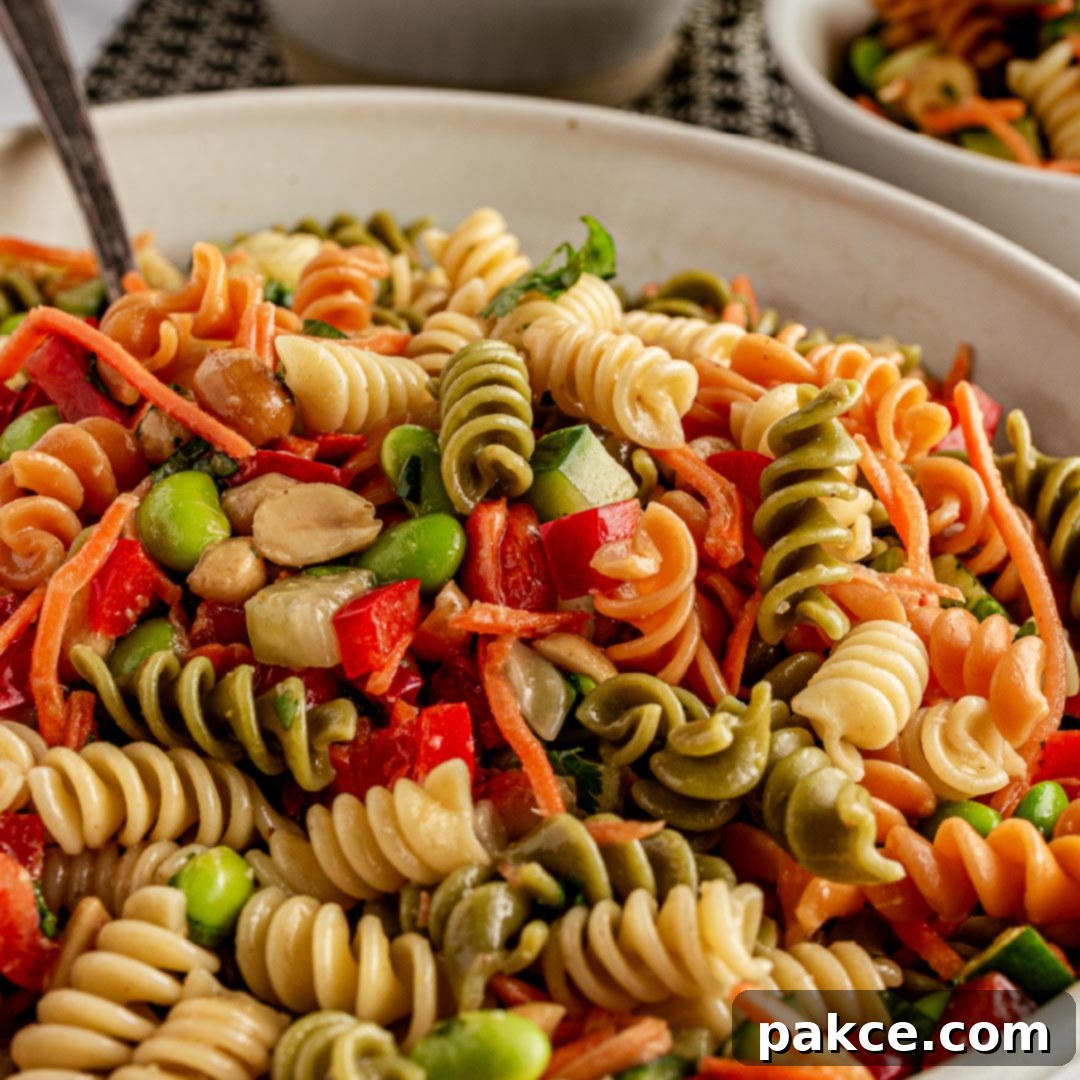Flavorful Thai Pasta Salad with Homemade Sesame Ginger Dressing: Your Ultimate Side Dish!
Transport your taste buds to the vibrant flavors of Thailand with this incredibly delicious and easy-to-make Thai Pasta Salad, perfectly complemented by a luscious Sesame Ginger Dressing. This dish isn’t just a side; it’s a celebration of color, texture, and taste, bringing together crisp carrots, sweet red bell pepper, protein-rich edamame, and crunchy peanuts, all tossed with spiral pasta and generously coated in a zesty, aromatic ginger dressing. Whether you’re planning a picnic, a potluck, or just a delightful family meal, this Thai noodle salad promises to impress with its fresh ingredients and harmonious blend of sweet, savory, and tangy notes. Get ready to elevate your side dish game with this irresistible recipe!
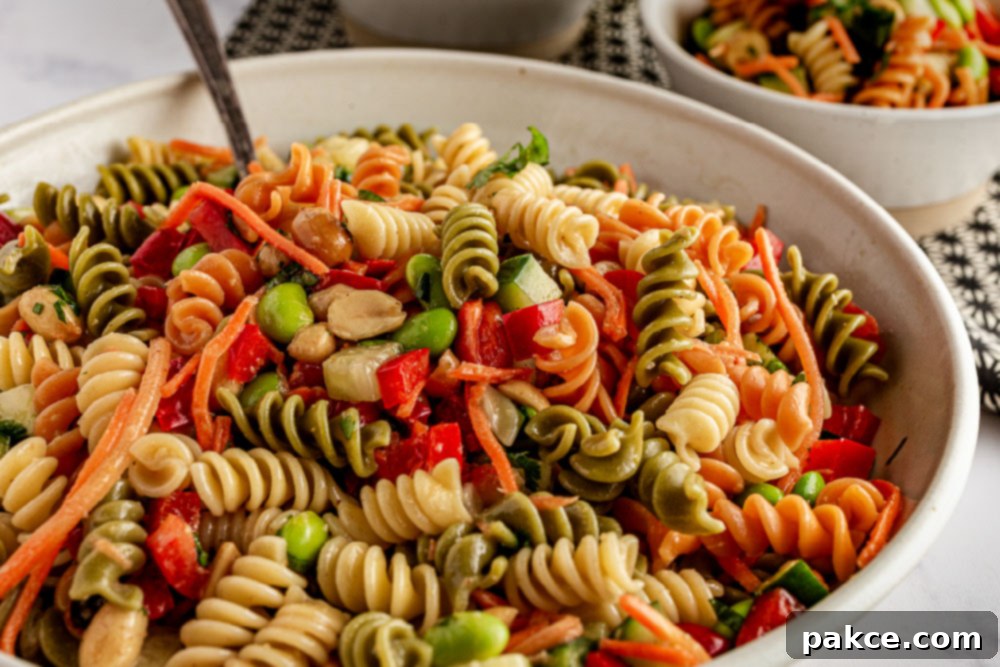
[feast_advanced_jump_to]
Watch the Recipe Video!
Visual learners, rejoice! Our detailed recipe video provides a fantastic step-by-step walkthrough of making this incredible Thai Pasta Salad. From expertly preparing the fresh, colorful vegetables to blending the perfect, emulsified sesame ginger dressing, you’ll gain all the confidence you need to recreate this dish. Watch our culinary guide and get ready to add a splash of Thai-inspired goodness to your kitchen!
Why You’ll Love This Thai Pasta Salad Recipe
This Thai-inspired pasta salad isn’t just another side dish; it’s a complete culinary experience that brings a burst of fresh flavors and exciting textures to your table. Here’s why this recipe will quickly become a cherished favorite:
- Vibrant and Visually Appealing: The harmonious combination of crisp red bell peppers, bright shredded carrots, and verdant edamame creates a stunning visual spectacle that will impress guests and brighten any meal.
- Explosion of Authentic Flavors: The star of this dish is undoubtedly the homemade Sesame Ginger Dressing. It masterfully balances sweet honey, tangy rice wine vinegar, savory tamari, a hint of spicy sriracha, and the invigorating kick of freshly grated ginger. Every ingredient is beautifully coated, ensuring a perfectly seasoned and delicious bite every time.
- Delightful Array of Textures: Experience a symphony of textures with every forkful: the satisfying chewiness of al dente spiral pasta, the refreshing crispness of diced cucumbers, the tender bite of edamame, and the irresistible crunch of whole cocktail peanuts.
- Effortlessly Easy to Prepare: Despite its gourmet appearance and complex flavor profile, this salad is surprisingly simple to assemble. It’s an ideal choice for busy weeknights, impromptu gatherings, or when you need an impressive dish without the fuss. Plus, the dressing can be prepped days ahead!
- Incredibly Versatile: This pasta salad serves beautifully as a refreshing side dish alongside grilled chicken, flaky fish, pan-seared tofu, or even succulent shrimp. It’s also substantial enough to be enjoyed as a light vegetarian main course or a vibrant addition to potlucks, picnics, and summer barbecues.
- Wholesome and Nutritious: Packed with an abundance of fresh vegetables and boasting plant-based protein from the edamame and peanuts, this salad offers a wholesome and satisfying option that doesn’t compromise on its fantastic taste.
Essential Ingredients for Your Thai Pasta Salad
Crafting the perfect Thai Pasta Salad begins with selecting high-quality, fresh ingredients. This recipe is thoughtfully divided into two main components to guide you: the irresistible Sesame Ginger Dressing and the vibrant pasta salad itself. Here’s a detailed look at what you’ll need to create this culinary masterpiece:
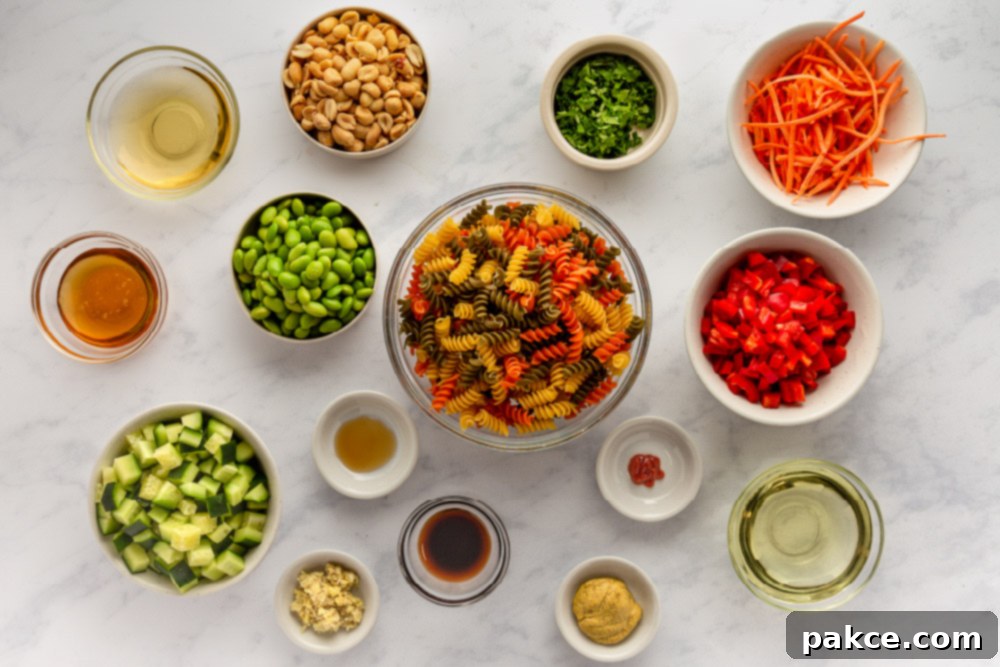
For the Sesame Ginger Dressing:
- Vegetable Oil: This forms the smooth, neutral base of our dressing, allowing the more assertive Asian flavors to take center stage. Canola or grapeseed oil are also excellent alternatives.
- Rice Wine Vinegar: Essential for adding that characteristic tangy, slightly sweet, and bright acidity that cuts through the richness of the oil and balances the flavors beautifully. Opt for unseasoned rice wine vinegar.
- Tamari or Soy Sauce: Delivers the crucial umami depth and savory saltiness that is foundational to Asian dressings. Tamari is a fantastic gluten-free alternative, often preferred for its richer, less harsh flavor profile.
- Dijon Mustard: Beyond adding a subtle, sharp kick, Dijon acts as a natural emulsifier, helping to bind the oil and vinegar together into a silky-smooth, cohesive dressing.
- Freshly Grated Ginger: The true star, infusing the dressing with its warm, spicy, and incredibly aromatic essence. Using fresh ginger is non-negotiable for the best flavor; avoid powdered ginger here.
- Honey: Provides a natural sweetness that perfectly balances the acidity of the vinegar and the savory notes of the tamari. For a vegan option, maple syrup or agave nectar can be substituted.
- Toasted Sesame Oil: A powerful flavor enhancer! Just a small amount imparts a deep, nutty, and unmistakably Asian aroma and taste. Ensure it’s “toasted” for that signature fragrant quality.
- Sriracha Hot Sauce: Introduces a pleasant touch of heat and a hint of garlic. Adjust the quantity to fine-tune the spice level to your personal preference, from mild to fiery.
For the Thai Pasta Salad:
- Diced Cucumber: Offers a wonderfully refreshing, crisp texture and a cool, hydrating contrast to the vibrant dressing.
- Diced Red Bell Pepper: Contributes a beautiful splash of color, a sweet crunch, and a healthy dose of essential vitamins, making the salad visually appealing and nutritious.
- Shredded Carrots: Adds a natural sweetness, another layer of brilliant orange color, and a delicate crunch that complements the other vegetables.
- Whole Cocktail Peanuts: Crucial for that quintessential Thai-inspired crunch and rich, nutty flavor. Using whole peanuts provides a satisfying bite; ensure they are unsalted or lightly salted.
- Finely Chopped Fresh Cilantro Leaves: A burst of fresh, herbaceous, and bright flavor that invigorates the entire salad. Don’t skip this; it’s key to the fresh taste.
- Steamed and Shelled Edamame: Introduces a delightful chewiness and a significant boost of plant-based protein and fiber, making the salad more substantial and satisfying.
- Tri-color Rotini: The spiral shape of rotini pasta is ideal for capturing and holding onto the flavorful dressing and small pieces of vegetables, ensuring every bite is perfectly balanced. Feel free to use any short pasta shape or even Asian-style noodles.
Step-by-Step Guide: How to Assemble Your Thai Pasta Salad
Preparing this vibrant Thai Pasta Salad is a surprisingly straightforward process, broken down into two main stages: crafting the aromatic dressing and then combining the fresh salad components. Follow these detailed steps to achieve a perfectly balanced and flavorful outcome every time.
Preparing the Sesame Ginger Dressing:
One of the best features of this homemade Sesame Ginger Dressing is its make-ahead potential. It can be prepared up to 4 days in advance and stored in an airtight container in the refrigerator, allowing the complex flavors to deepen and meld beautifully over time.
- Gather and Measure: Begin by precisely measuring all your dressing ingredients: vegetable oil, rice wine vinegar, tamari or soy sauce, Dijon mustard, freshly grated ginger, honey, toasted sesame oil, and sriracha hot sauce.
- Combine for Blending: Carefully pour all the measured dressing ingredients into the container of an immersion blender. If an immersion blender isn’t available, a standard upright blender or even a food processor will work just as effectively to create a smooth consistency.
- Emulsify to Perfection: Blend the mixture for 1-2 minutes continuously. The goal is to achieve a completely smooth, creamy, and beautifully emulsified consistency. Using a whisk is generally not recommended for this particular dressing, as it often struggles to fully combine the oil and vinegar, which can result in a less unified and flavorful dressing.
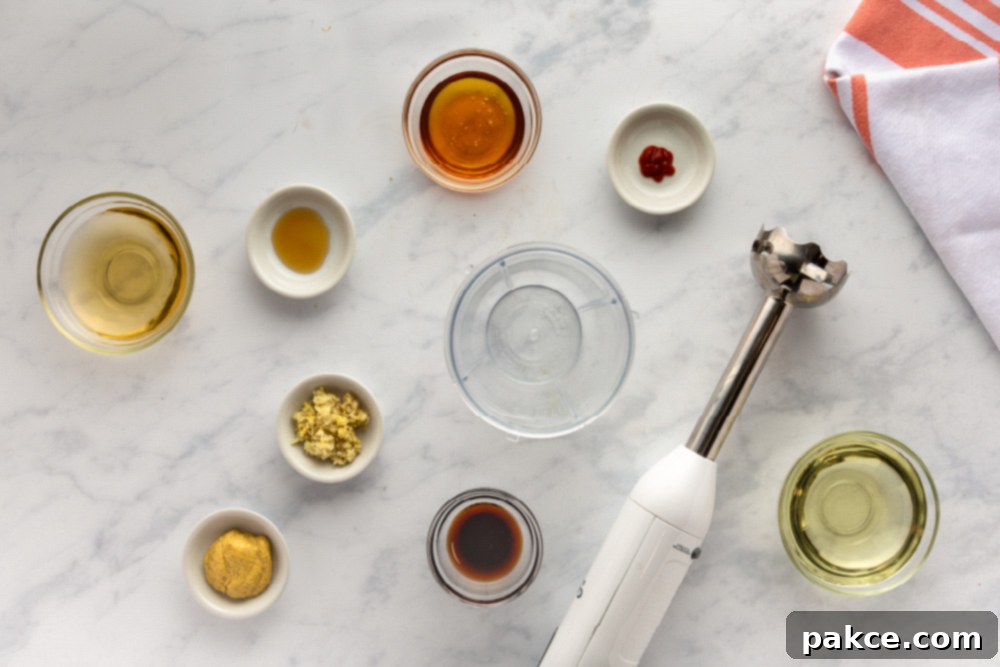
Assembling the Thai Pasta Salad:
- Cook the Pasta: Begin by bringing a large pot of generously salted water to a rolling boil. Add your chosen pasta, such as tri-color rotini, and cook it precisely according to the package directions until it reaches an al dente texture. This is key for a good pasta salad.
- Prepare Fresh Vegetables: While your pasta is cooking, take this time to dice your cucumber and red bell pepper, shred the carrots, finely chop the fresh cilantro, and ensure your edamame is steamed, shelled, and allowed to cool completely.
- Combine Salad Base: In a large mixing bowl (one with a lid is ideal for easy chilling), combine the freshly diced cucumber, red bell pepper, vibrant shredded carrots, crunchy whole cocktail peanuts, aromatic chopped cilantro, and the cooled edamame. This colorful medley forms the delicious heart of your salad.
- Cool the Pasta Thoroughly: Once the pasta is cooked to al dente, drain it completely in a colander. Immediately rinse it with a steady stream of cold water until the pasta is fully cooled to the touch. This crucial step halts the cooking process, prevents the pasta from becoming gummy, and ensures it retains a pleasant texture in the cold salad. Be sure to drain it very well after rinsing to avoid excess water in your salad.
- Add Pasta to Veggies: Transfer the cooled and thoroughly drained pasta to the large bowl containing your prepared vegetables. Gently toss all the ingredients together to ensure an even distribution before adding the dressing.
- Dress the Salad: Pour the luscious, prepared Sesame Ginger Dressing evenly over the pasta and vegetable mixture. Using a large spoon or salad tongs, mix everything thoroughly but gently, ensuring every single piece is beautifully coated with the flavorful dressing.
- Chill and Serve: For the most optimal flavor development and refreshing texture, refrigerate the finished salad for a minimum of 1-2 hours or until it is completely chilled and ready to be served. If your preparation timeline extends beyond two hours, it’s highly recommended to store the dressing and the salad components separately in airtight containers. Then, combine them just 1-2 hours before serving to ensure the vegetables remain crisp and the pasta maintains its ideal texture.
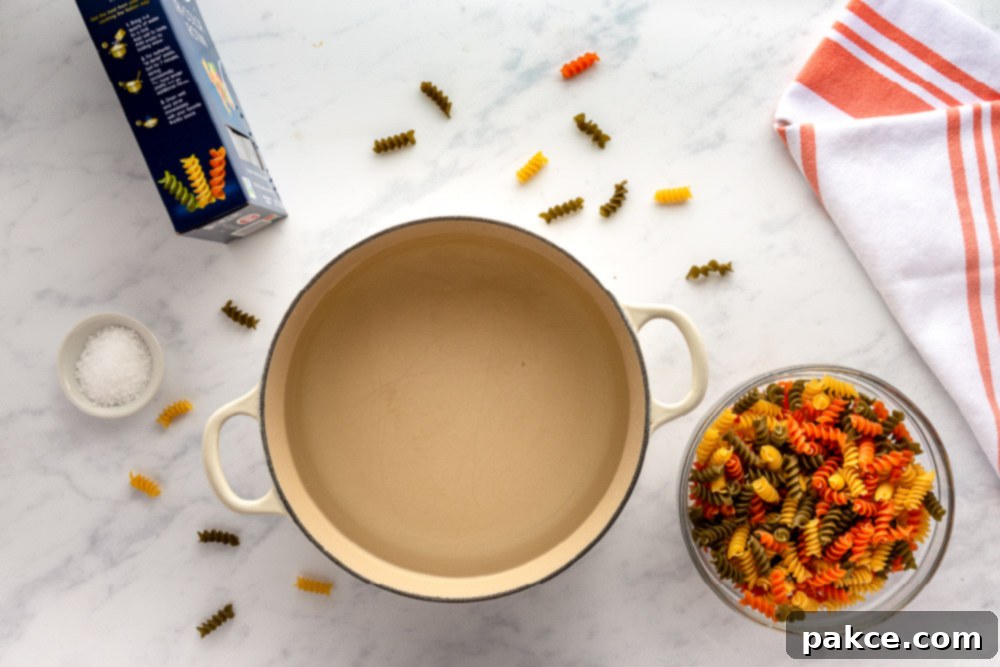
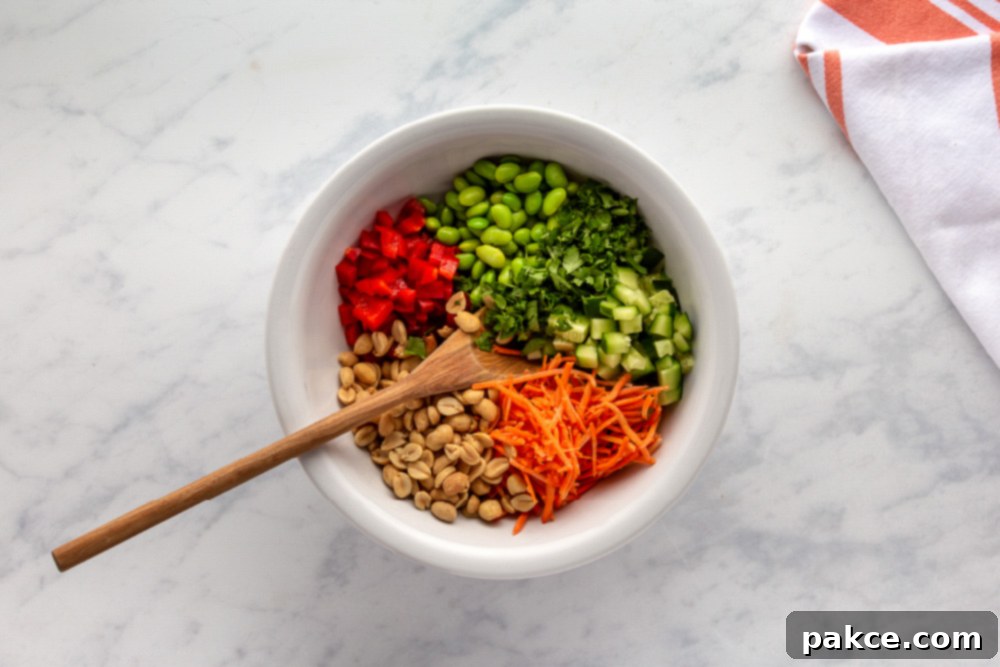
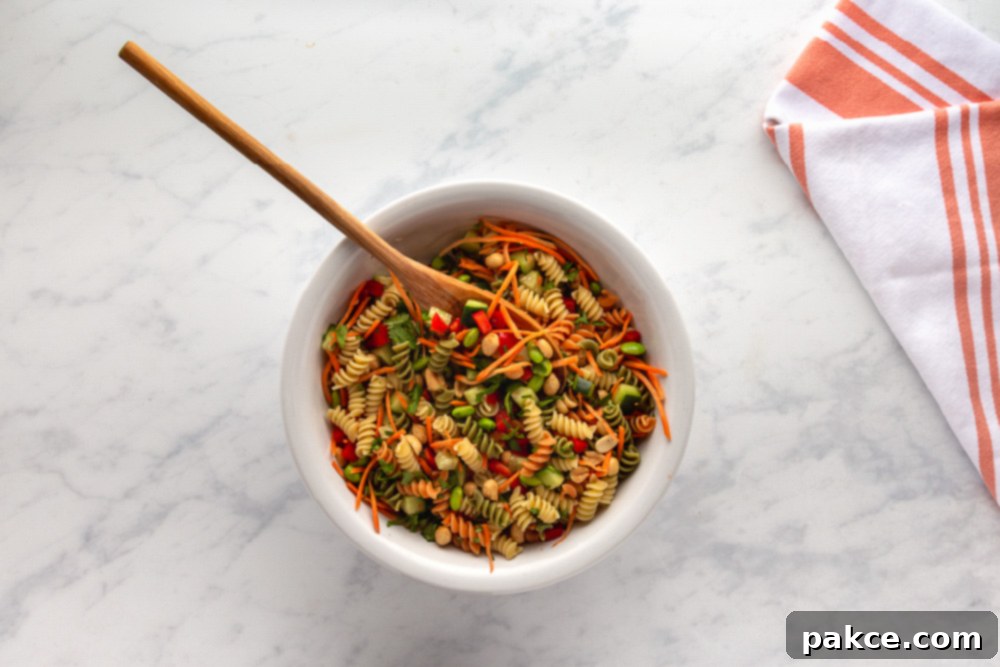
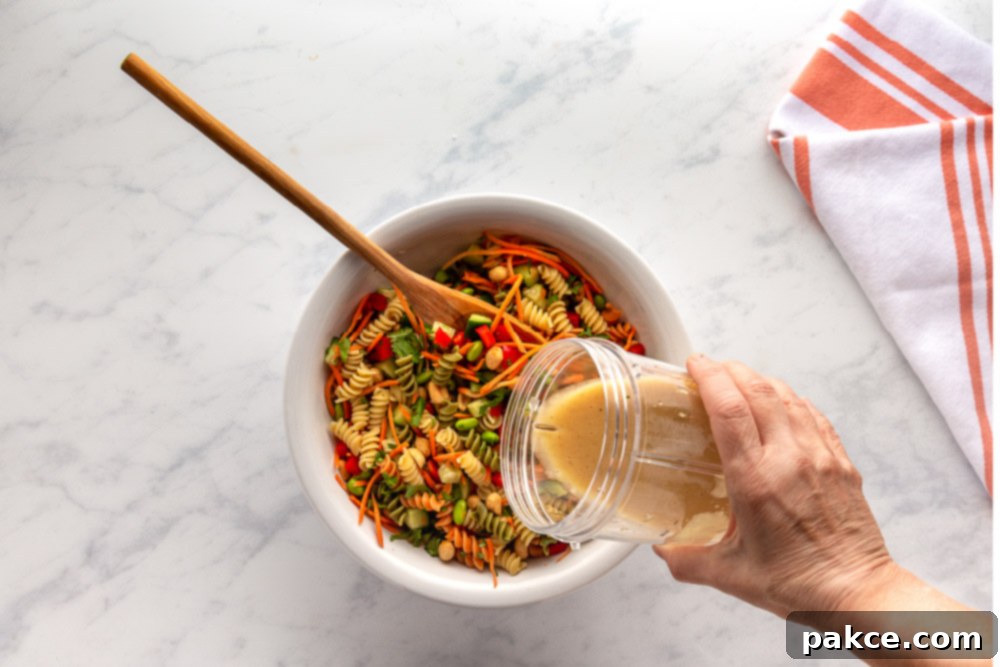
Pro Tips and Recipe Variations
Take your Thai Pasta Salad to the next level and make it truly your own with these expert tips and creative variations:
- Achieving Perfect Pasta: Always aim to cook your pasta al dente – firm to the bite. Overcooked pasta will become mushy, especially after chilling in a salad. Immediately rinsing the cooked pasta with cold water after draining is crucial; it halts the cooking process and washes away excess starch, preventing stickiness.
- Enhanced Flavor Development: The dressing’s complex flavors truly shine after a little time. Preparing the Sesame Ginger Dressing a day in advance allows the ginger, sriracha, and sesame oil to fully meld and deepen, resulting in an even more harmonious and potent taste.
- Boost the Protein: To transform this delightful side dish into a satisfying main course, consider adding cooked and shredded chicken breast, grilled shrimp, pan-seared tofu cubes, or even thinly sliced grilled steak. These additions complement the Asian flavors beautifully.
- Expand Your Veggie Palette: Feel free to customize this salad with other crisp and colorful vegetables. Julienned jicama, thinly sliced red cabbage, crisp snap peas, blanched broccoli florets, or even chopped mango for a sweet and tangy twist would all be excellent additions.
- Aromatic Herb Power: Beyond the fresh cilantro, experiment with adding other fragrant herbs like fresh mint leaves or Thai basil. These will introduce an additional layer of aromatic complexity and freshness to the salad.
- Nutty Crunch Alternatives: If you’re out of peanuts, or catering to a peanut allergy, there are several fantastic substitutes. Toasted cashews or slivered almonds offer a wonderful texture and mild nutty flavor. For a completely nut-free option, toasted sunflower seeds or pumpkin seeds provide a delightful crunch. If allergies are severe, ensure all ingredients are certified peanut-free.
- Customize the Spice Level: If you adore heat, don’t hesitate to increase the amount of sriracha in the dressing. For an extra kick, a pinch or two of red pepper flakes can be added directly to the salad, or incorporate a dash of chili oil or a spoonful of chili paste for deeper heat.
Frequently Asked Questions About Thai Pasta Salad
Edamame (pronounced ed-uh-mah-mey) refers to young, immature soybeans that are harvested before they harden. They are a beloved snack and ingredient in Asian cuisine, typically found in the freezer aisle, either still in their pods or already shelled. Edamame is highly prized for its vibrant green color, subtly sweet and nutty flavor, and impressive nutritional profile, serving as an excellent source of plant-based protein, fiber, and various vitamins and minerals.
To prepare them for this pasta salad, if you’re starting with frozen edamame in the pod, simply boil or steam them according to the package instructions until they are tender-crisp, usually about 3-5 minutes. Once cooked, quickly drain and rinse them under cold water to stop the cooking process and cool them down. Then, pop the bright green beans out of their pods. If you’re using pre-shelled edamame, the process is even simpler: just steam or boil until tender, then cool completely before adding them to your salad mixture.
Tamari is a specific type of Japanese soy sauce that distinguishes itself from standard soy sauce in a few significant ways. Historically, it is a byproduct of miso paste fermentation and traditionally contains little to no wheat, making it an excellent naturally gluten-free option (though it’s always wise to check the label for certification, as some brands might include trace amounts). Its flavor profile is generally richer, darker, and often described as less salty than conventional soy sauce. Tamari offers a more balanced, complex, and profound umami depth, which is why it’s often preferred by chefs for applications where its nuanced flavor can truly shine, such as in delicate dressings and marinades.
While tamari can sometimes be slightly more expensive and occasionally harder to locate in conventional supermarkets compared to standard soy sauce, its superior flavor for fine applications like salad dressings is often well worth the extra effort. For recipes that demand larger quantities, such as extensive marinades or stir-fry sauces, regular soy sauce can be a more economical and widely available substitute. Just be mindful that you might need to adjust the overall saltiness of your dish accordingly, as standard soy sauce tends to be saltier.
Grating fresh ginger is a crucial step for this recipe, as it fully extracts the potent aromatic and spicy oils that are central to our Sesame Ginger Dressing. You’ll find fresh ginger root in the produce section of most grocery stores. Here’s the best way to prepare it:
- Peel the Skin: First, you’ll need to remove the tough, papery outer skin. A vegetable peeler works efficiently for larger, straighter pieces of ginger. However, for smaller, more irregular knobs, the edge of a spoon is surprisingly effective at gently scraping off the skin without wasting too much of the precious ginger underneath. Only peel the section of ginger you intend to use.
- Choose Your Grater: For the finest grating that maximizes flavor release and minimizes fibrous texture, a microplane grater is your ideal tool. If you don’t have a microplane, the smallest holes on a standard box grater will also work effectively, though the result might be slightly coarser.
- Grate and Collect: Hold the unpeeled end of the ginger root firmly to maintain a good grip, then rub the peeled section vigorously across the grating surface directly over a bowl or measuring spoon to catch the grated ginger. As you grate, you’ll accumulate finely minced ginger. Periodically scrape the back side of the grater to clear any accumulated ginger and ensure all the flavorful pulp makes its way into your dish. Aim for 1 to 3 tablespoons, depending on how much you love the vibrant kick of ginger!
Yes, this Thai Pasta Salad is an excellent candidate for meal preparation or making ahead for gatherings and parties! However, to ensure the best possible texture and prevent the pasta from becoming overly soft or the crisp vegetables from losing their crunch, it is highly recommended to store the salad components separately if you are preparing it more than two hours before serving. Keep the cooked and thoroughly cooled pasta, the prepared medley of vegetables (diced cucumber, bell pepper, shredded carrots, edamame, cilantro, and peanuts), and the flavorful sesame ginger dressing in individual airtight containers in the refrigerator. Then, approximately 1-2 hours before you plan to serve, simply combine all the elements and toss them thoroughly to coat with the dressing. This method ensures that your salad remains remarkably fresh, vibrant, and perfectly textured, allowing the flavors to meld without compromising quality.
The base recipe for our Thai Pasta Salad with Sesame Ginger Dressing includes a modest amount of sriracha hot sauce, which provides a very mild and pleasant warmth rather than an intense, fiery heat. This carefully calibrated spice level makes it enjoyable and accessible for most palates, including those who prefer milder flavors. However, if you are a true enthusiast of spicy cuisine and wish to significantly amplify the heat, you have several straightforward options: you can gradually increase the amount of sriracha directly in the dressing until it reaches your desired kick, or add a pinch or two of crushed red pepper flakes directly into the salad. For an even deeper and more complex heat, consider incorporating a spoonful of chili paste or a drizzle of chili oil. For those seeking an authentic Thai-style fiery experience, finely mincing a fresh Thai bird chili and adding it to the dressing or salad can provide a powerful kick, but proceed with caution as these chilies are extremely hot!
Absolutely! While tri-color rotini is an excellent choice for its vibrant appearance and ability to effectively capture the dressing and small vegetable pieces, this Thai Pasta Salad is remarkably versatile when it comes to pasta selection. Any short, sturdy pasta shape will work beautifully and hold up well in a cold salad. Great options include fusilli (similar to rotini), penne, orecchiette (little ears, perfect for scooping up dressing), farfalle (bow-tie pasta), or even elbow macaroni for a more classic pasta salad feel. If you’re looking to lean more into a “noodle salad” concept, consider Asian-style noodles such as soba noodles (buckwheat noodles, which have a distinctive earthy flavor), thin rice vermicelli, or broader flat rice noodles. You can even use spaghetti or linguine broken into shorter pieces. Regardless of your choice, always ensure to cook the alternative pasta according to its specific package directions until al dente, and cool it thoroughly before combining with the other ingredients.
Making this delicious Thai Pasta Salad completely gluten-free is quite straightforward! The key ingredients to carefully consider for gluten content are the pasta itself and the soy sauce or tamari used in the dressing. To start, opt for a certified gluten-free pasta; there are many excellent options available today made from ingredients like rice, corn, brown rice, or various legumes (chickpea, lentil), all of which work wonderfully in this recipe. Alternatively, you can substitute with gluten-free rice noodles (vermicelli or flat rice noodles) or soba noodles, but ensure that any soba noodles you choose are 100% buckwheat, as some brands may include wheat flour. For the dressing, it is imperative to use gluten-free tamari, which is naturally wheat-free. Most other ingredients, such as fresh vegetables, honey, oils, and sriracha, are typically gluten-free. However, it’s always a diligent practice to double-check the labels of all packaged ingredients to confirm there are no hidden sources of gluten, especially if you are preparing the salad for someone with severe gluten sensitivities or Celiac disease.
Yes, you can absolutely make this Thai Pasta Salad completely peanut-free to accommodate allergies or personal preferences! The simplest approach is to merely omit the peanuts from the recipe. However, to retain a similar delightful crunch and a hint of nutty flavor, you have several excellent and delicious substitutes:
- Cashews or Almonds: If you are not avoiding all tree nuts, toasted cashews or slivered almonds offer a wonderful texture and a mild, complementary nutty flavor that pairs well with the dressing.
- Sunflower Seeds or Pumpkin Seeds: For a strictly nut-free option (ensuring they are from a certified nut-free facility if severe allergies are a concern), toasted sunflower seeds or pumpkin seeds provide a fantastic crunch and a boost of healthy fats and nutrients.
- Toasted Chickpeas: As a creative and satisfying alternative for added texture, roasting chickpeas until they are golden brown and crispy can provide a unique and delicious crunch that mimics the role of peanuts.
Always remember to carefully double-check the labels of all ingredients to prevent any potential cross-contamination if you are preparing this salad for someone with a severe peanut allergy.
While the original recipe for this Thai Pasta Salad is designed to be flavorful without the inclusion of onion, it is indeed a fantastic ingredient to add if you appreciate its pungent bite and aromatic qualities! Incorporating onion can introduce another layer of depth and zest to the salad. For this particular Thai-inspired dish, I would highly recommend using either finely chopped red onion or thinly sliced green onion (scallions) to best complement the existing flavors.
- Red Onion: Offers a sharper, more distinct flavor and a beautiful, vibrant purple hue that enhances the salad’s visual appeal. If you find raw red onion too strong or overpowering, a quick trick is to finely dice it and then soak it in a bowl of cold water for 10-15 minutes. This simple step helps to mellow its intensity significantly.
- Green Onion (Scallions): Provides a milder, fresher, and more delicate onion flavor, particularly the green tops, which also add a lovely garnish and a touch of color. Green onions tend to blend well with the other ingredients without dominating the overall flavor profile.
Both options will undoubtedly add another layer of complexity and freshness to your salad, so feel free to choose based on your personal preference for onion intensity!
This incredibly versatile Thai Pasta Salad can be enjoyed in a multitude of ways, making it a truly adaptable dish! It is absolutely perfect as a refreshing and flavorful side dish, complementing grilled meats such as succulent chicken skewers, tender pork tenderloin, or flaky white fish like cod or snapper. It also shines brightly alongside other Asian-inspired main courses, such as vibrant stir-fries, crispy spring rolls, or savory grilled tofu. For a satisfying yet light vegetarian lunch, this salad is hearty enough to be enjoyed on its own, perhaps with an extra sprinkle of peanuts or a few more edamame for an added protein boost. Beyond everyday meals, it’s a guaranteed superstar at picnics, potlucks, and barbecues, as it holds up exceptionally well and, like many great cold salads, often tastes even better as the flavors have more time to meld and deepen.
Proper storage is key to enjoying your Thai Pasta Salad for longer. Any leftover salad should be transferred to an airtight container and stored in the refrigerator. It will generally keep well for 2-3 days, making it an excellent option for meal prepping throughout the week. You might even find that the flavors tend to deepen and become more harmonious overnight, making it even more delicious on the second day! However, please note that over time, the pasta may absorb more of the dressing and soften slightly, and the peanuts might lose some of their initial crispness. If you wish to maximize the freshness and texture for subsequent servings, consider keeping a small separate portion of fresh, chopped peanuts or a sprinkle of cilantro to add just before serving your leftovers.
Full Recipe Details
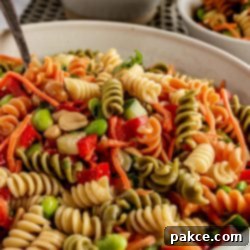
Thai Pasta Salad with Sesame Ginger Dressing
Add to Shopping ListGo to Shopping List
